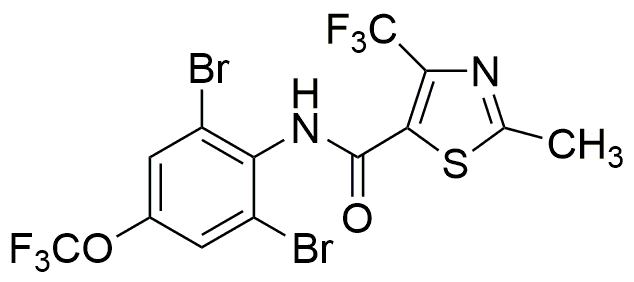Thifluzamide is widely utilized in research focused on:
- Agricultural Pest Control: This chemical is primarily used as a fungicide in agriculture, effectively controlling various fungal diseases in crops such as rice and vegetables, which helps improve yield and quality.
- Plant Protection Products: It is incorporated into formulations designed to protect plants from pathogens, ensuring healthier crops and reducing the need for multiple treatments, thus saving time and resources for farmers.
- Integrated Pest Management (IPM): Thifluzamide plays a crucial role in IPM strategies, allowing farmers to use it in conjunction with other pest control methods, promoting sustainable agricultural practices.
- Research in Plant Pathology: Researchers utilize this compound to study its effects on various fungal species, helping to develop new strategies for disease management and enhancing understanding of plant-fungal interactions.
- Environmental Safety Assessments: Its application in studies assessing the environmental impact of fungicides aids in developing safer agricultural practices, ensuring minimal harm to non-target organisms and ecosystems.
General Information
Properties
Safety and Regulations
Applications
Thifluzamide is widely utilized in research focused on:
- Agricultural Pest Control: This chemical is primarily used as a fungicide in agriculture, effectively controlling various fungal diseases in crops such as rice and vegetables, which helps improve yield and quality.
- Plant Protection Products: It is incorporated into formulations designed to protect plants from pathogens, ensuring healthier crops and reducing the need for multiple treatments, thus saving time and resources for farmers.
- Integrated Pest Management (IPM): Thifluzamide plays a crucial role in IPM strategies, allowing farmers to use it in conjunction with other pest control methods, promoting sustainable agricultural practices.
- Research in Plant Pathology: Researchers utilize this compound to study its effects on various fungal species, helping to develop new strategies for disease management and enhancing understanding of plant-fungal interactions.
- Environmental Safety Assessments: Its application in studies assessing the environmental impact of fungicides aids in developing safer agricultural practices, ensuring minimal harm to non-target organisms and ecosystems.
Documents
Safety Data Sheets (SDS)
The SDS provides comprehensive safety information on handling, storage, and disposal of the product.
Product Specification (PS)
The PS provides a comprehensive breakdown of the product’s properties, including chemical composition, physical state, purity, and storage requirements. It also details acceptable quality ranges and the product's intended applications.
Certificates of Analysis (COA)
Search for Certificates of Analysis (COA) by entering the products Lot Number. Lot and Batch Numbers can be found on a product’s label following the words ‘Lot’ or ‘Batch’.
*Catalog Number
*Lot Number
Certificates Of Origin (COO)
This COO confirms the country where the product was manufactured, and also details the materials and components used in it and whether it is derived from natural, synthetic, or other specific sources. This certificate may be required for customs, trade, and regulatory compliance.
*Catalog Number
*Lot Number
Safety Data Sheets (SDS)
The SDS provides comprehensive safety information on handling, storage, and disposal of the product.
DownloadProduct Specification (PS)
The PS provides a comprehensive breakdown of the product’s properties, including chemical composition, physical state, purity, and storage requirements. It also details acceptable quality ranges and the product's intended applications.
DownloadCertificates of Analysis (COA)
Search for Certificates of Analysis (COA) by entering the products Lot Number. Lot and Batch Numbers can be found on a product’s label following the words ‘Lot’ or ‘Batch’.
*Catalog Number
*Lot Number
Certificates Of Origin (COO)
This COO confirms the country where the product was manufactured, and also details the materials and components used in it and whether it is derived from natural, synthetic, or other specific sources. This certificate may be required for customs, trade, and regulatory compliance.


